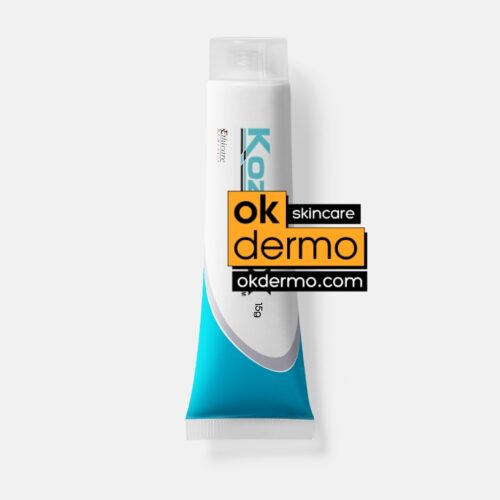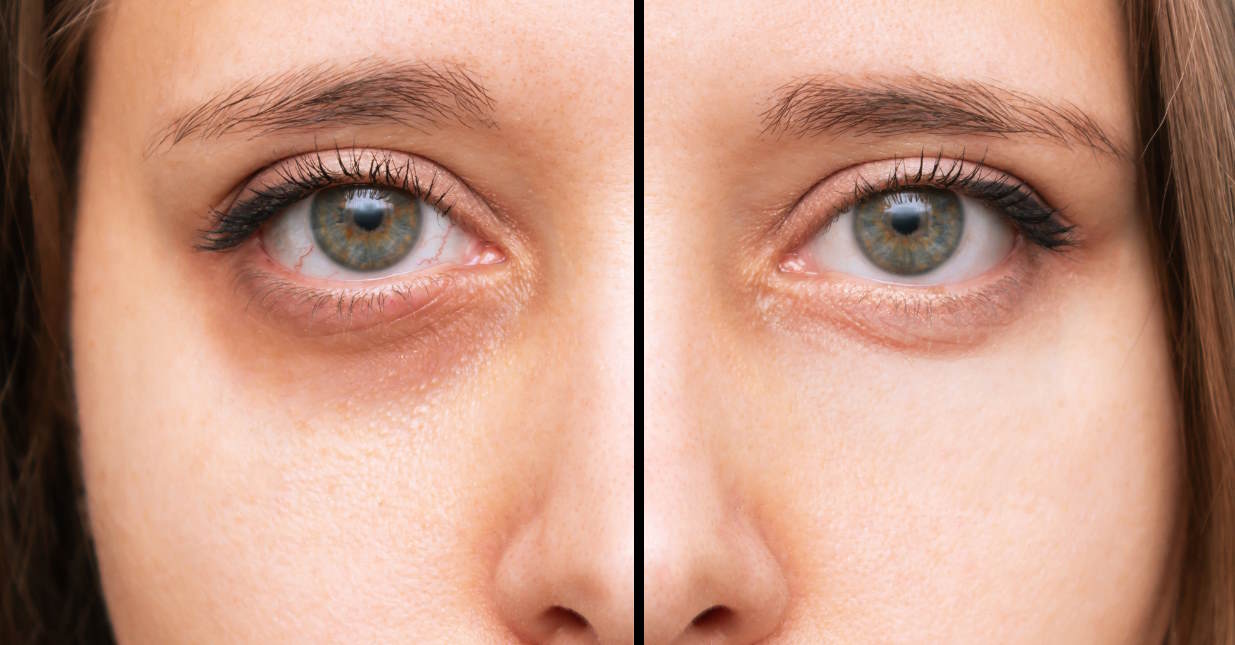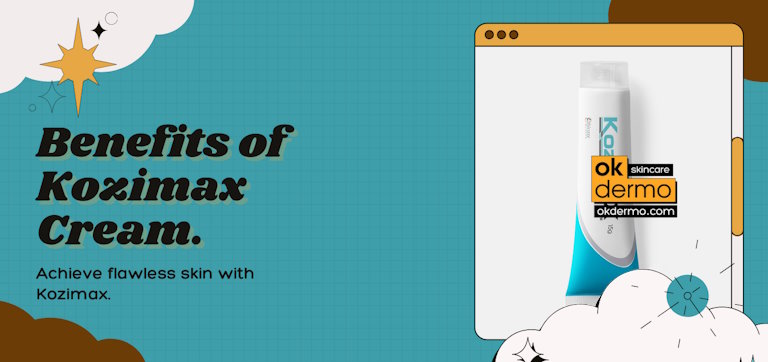How to Use Kozimax Cream, Benefits, Side Effects, and More
Table of Contents
Kozimax cream is a common topical formulation used in dermatology primarily for the treatment of disorders associated with hyperpigmentation such as post-inflammatory hyperpigmentation, melasma, and sunspots.
This comprehensive guide aims to provide detailed information on the use, benefits, and side effects of Kozimax Cream, supported by clinical evidence and expert recommendations.
What is Kozimax Cream?
Kozimax Cream is a combination of active ingredients such as kojic acid, arbutin, glabridin, Vitamin C, Vitamin A, and Vitamin E that work synergistically to inhibit the production of melanin which determines the degree of your skin coloration, thereby reducing hyperpigmentation and promoting a more even skin tone.
Additionally, the antioxidants present in Vitamin C and Vitamin E help protect the skin from damage caused by free radicals promoting a more youthful complexion.
-

Kozimax® Natural Skin Whitening Cream
Kojic Acid 5% + Vitamin C 10% + Arbutin 1% + Glabridin 1% + Vitamins A, E
Size: 15g / 0.53oz
USD $26.00 Add to cart
Active Ingredients and Kozimax Cream Benefits
Kozimax cream’s benefits and mechanism of action revolve around its key ingredients: Kojic Acid, Arbutin, Glabridin, Vitamin C, Vitamin E, and A.
Kojic Acid: This ingredient is derived from several species of fungi and acts as a tyrosinase inhibitor. Tyrosinase is a key enzyme involved in the production of melanin. By inhibiting tyrosinase activity, kojic acid reduces the formation of melanin, thus helping to lighten dark spots and even out skin tone.
Arbutin: Another tyrosinase inhibitor, arbutin is a naturally occurring compound that works similarly to kojic acid by blocking the enzymatic pathway responsible for melanin synthesis. Arbutin is particularly effective in treating melasma and other forms of hyperpigmentation due to its ability to penetrate the skin better and inhibit melanin production.
Glabridin: By inhibiting tyrosinase, glabridin also helps to reduce the production of melanin, leading to a lighter complexion.
Vitamin C: Also known as ascorbic acid, vitamin C is a potent antioxidant with skin-brightening properties. It helps to reduce oxidative stress caused by free radicals in the skin, which can contribute to hyperpigmentation. Additionally, vitamin C plays a crucial role in collagen synthesis, promoting skin healing and rejuvenation.
Vitamin E: Like vitamin C, vitamin E is an antioxidant that helps protect the skin from damage caused by environmental factors such as UV radiation and pollution. It also has anti-inflammatory properties, which can help soothe irritated skin and promote healing.
When applied topically, Kozimax cream delivers these active ingredients directly to the affected areas, where they work synergistically to inhibit melanin production, reduce existing pigmentation, and improve overall skin tone.
Clinical Studies and Trials
Numerous clinical studies have evaluated the efficacy and safety of the ingredients of Kozimax Cream in treating hyperpigmentation disorders. These trials have demonstrated significant improvements in pigmentation levels and patient satisfaction following regular use of products containing such active ingredients.
However, it is important to note that while there have been numerous studies proving the efficacy and the safety of these active ingredients, specific studies on the efficacy of Kozimax cream itself are yet to be concluded.
Kozimax Skin Lightening Cream
Kozimax cream is specifically formulated to lighten the skin and reduce hyperpigmentation. Its active ingredients target the melanocytes, the cells responsible for producing melanin, and inhibit the enzymatic processes involved in melanin synthesis.
Regular use of Kozimax cream can lead to a gradual lightening of dark spots, blemishes, and uneven skin tone, resulting in a more radiant complexion.
Kozimax Cream for Dark Circles
While Kozimax cream is primarily designed for skin lightening and reducing hyperpigmentation, it may also be used to diminish the appearance of dark circles under the eyes.
The lightening properties of the cream can help in fading the pigmentation around the eyes and making the skin appear brighter and more refreshed. However, it’s crucial to be gentle while applying the cream in the delicate eye area and to avoid getting it into the eyes.

How to Use Kozimax Cream
Here is a detailed guide on how to use Kozimax cream effectively:
- Cleanse the Skin:
Before applying Kozimax cream, make sure that your skin is clean and dry. Use a gentle cleanser suitable for your skin type to remove any dirt or makeup and pat the skin dry with a towel.
- Apply a Thin Layer:
Take a small amount of Kozimax cream on your fingertips and gently apply a thin layer of the cream to the affected areas of the skin. Avoid applying it to open wounds.
- Massage in Circular Motions:
Using your fingertips, gently massage the cream into the skin using circular motions until it is fully absorbed. Ensure even distribution of the cream over the entire affected area.
- Use Twice Daily:
For the best results, use Kozimax cream twice daily, preferably in the morning and evening. Keep in mind that consistent application is essential to achieve optimal outcomes.
- Follow with Sunscreen:
After applying Kozimax cream in the morning, follow up with a broad-spectrum sunscreen with a minimum SPF of 30. This helps protect the skin from harmful UV rays, which can exacerbate hyperpigmentation.
- Avoid Sun Exposure:
While using Kozimax cream, minimize sun exposure as much as possible, especially during peak hours. Wear protective clothing, such as hats and long sleeves, and seek shade when outdoors.
- Stay Hydrated:
Maintain skin hydration by drinking an adequate amount of water throughout the day. Hydrated skin is more receptive to topical treatments and can help improve the overall complexion.
- Be Patient and Consistent:
Visible results may take several weeks to manifest, so be patient and consistent with the use of Kozimax cream. Stick to the prescribed regimen and avoid skipping applications.
- Discontinue Use if Irritation Occurs:
If you experience any irritation, redness, or discomfort while using Kozimax cream, discontinue use immediately and consult a dermatologist. They can recommend alternative treatments or adjust the regimen accordingly.
- Store Properly:
Store Kozimax cream in a cool, dry place away from direct sunlight and heat. Keep the lid tightly closed to prevent contamination and degradation of the product.
By following these steps diligently, you can maximize the effectiveness of Kozimax cream in treating hyperpigmentation and achieving a brighter, more radiant complexion.
Kozimax Cream Results
The results of using Kozimax cream may vary depending on individual skin type, the severity of hyperpigmentation, and consistency of use. Some users may start noticing improvements in skin tone and texture within a few weeks of regular application, while others may require more extended periods to achieve desired results.
It’s essential to be patient and consistent with the use of Kozimax cream to experience maximum benefits.
Kozimax Cream Side Effects
The side effects of Kozimax Cream can be attributed to its active ingredients, including kojic acid and arbutin. These compounds can cause adverse reactions due to their potential to irritate the skin, induce allergic reactions, or lead to paradoxical hyperpigmentation.
The mechanisms underlying side effects vary depending on the specific reaction. Irritation may result from the disruption of the skin barrier function or inflammatory responses triggered by the active ingredients.
Allergic reactions involve immune-mediated responses to certain components of the cream, leading to erythema, itching, or even contact dermatitis.
Paradoxical hyperpigmentation may occur due to melanocyte stimulation or rebound melanogenesis following prolonged use of depigmenting agents.
In summary common side effects of Kozimax Cream range from mild to severe and may include:
Irritation: Redness, stinging sensation, burning, or peeling at the application site.
Allergic Reactions: Rash, hives, itching, swelling, or blistering.
Paradoxical Hyperpigmentation: Darkening of the skin beyond the areas of intended treatment.
Skin Sensitivity: Increased susceptibility to sunlight, leading to sunburn or photosensitivity reactions.
Tips for avoiding side effects
Management of Kozimax Cream side effects depends on the nature and severity of the reaction:
Discontinue Use: Cease application of the cream to prevent further irritation or adverse reactions.
Topical Steroids: Corticosteroid creams or ointments may alleviate inflammation and itching.
Emollients: Moisturizers can help soothe irritated skin and restore the skin barrier.
Sun Protection: Encourage strict sun avoidance and the use of broad-spectrum sunscreen to prevent exacerbation of photosensitivity reactions.
Contraindications
While Kozimax cream can be effective for many users, there are certain contraindications or situations where its use may not be suitable. Here are some common contraindications for Kozimax cream:
- Hypersensitivity: Avoid if allergic to any ingredients to prevent itching, redness, or swelling.
- Skin Irritation or Infection: Don’t use it on irritated, wounded, or infected skin as it may worsen the condition.
- Pregnancy and Breastfeeding: Consult a healthcare professional before using during these periods due to uncertain safety.
- Children: Exercise caution in children unless advised by a pediatrician due to their sensitive skin.
- Underlying Medical Conditions: Seek advice from a dermatologist if you have conditions like eczema or psoriasis to prevent aggravation.
Conclusion
In conclusion, Kozimax Cream offers a range of benefits in the management of hyperpigmentation disorders, including depigmentation, exfoliation, antioxidant protection, and the promotion of even skin tone. With its proven efficacy and favorable safety profile, Kozimax Cream remains a valuable therapeutic option for patients seeking to address unwanted skin pigmentation.
FAQs
-
What is Kozimax cream used for?
Kozimax cream is primarily used to treat hyperpigmentation, dark spots, melasma, and other skin discoloration issues. It contains ingredients that help lighten the skin and even out its tone.
-
Can you put Kozimax on your face?
Yes, Kozimax cream is formulated for topical application on the skin, including the face. However, it’s essential to perform a patch test before applying it widely to ensure compatibility with your skin type.
-
Is Kozimax cream the best for skin whitening?
The effectiveness of Kozimax cream for skin whitening may vary depending on individual skin types and conditions. While some users may experience positive results, it’s essential to consult with a dermatologist to determine the best treatment for your specific skin concerns.
-
What are the side effects of Kozimax cream?
Some potential side effects of Kozimax cream may include skin irritation, redness, itching, or dryness, especially for individuals with sensitive skin. Prolonged or excessive use may lead to adverse reactions, so it’s crucial to follow the instructions provided and discontinue use if any adverse effects occur.
References
- Videira IF, Moura DF, Magina S. Mechanisms regulating melanogenesis. A Bras Dermatol. 2013 Jan-Feb;88(1):76-83. doi: 10.1590/s0365-05962013000100009. PMID: 23539007; PMCID: PMC3699939.
- Xing X, Dan Y, Xu Z, Xiang L. Implications of Oxidative Stress in the Pathogenesis and Treatment of Hyperpigmentation Disorders. Oxid Med Cell Longev. 2022 Jan 18;2022:7881717. doi: 10.1155/2022/7881717. PMID: 35087618; PMCID: PMC8789419.
- Saeedi, M., Eslamifar, M., & Khezri, K. (2019). Kojic acid applications in cosmetic and pharmaceutical preparations. Biomedicine & pharmacotherapy = Biomedicine & pharmacotherapie, 110, 582–593. https://doi.org/10.1016/j.biopha.2018.12.006
- Wang, R. F., Ko, D., Friedman, B. J., Lim, H. W., & Mohammad, T. F. (2023). Disorders of hyperpigmentation. Part I. Pathogenesis and clinical features of common pigmentary disorders. Journal of the American Academy of Dermatology, 88(2), 271–288. https://doi.org/10.1016/j.jaad.2022.01.051
- Zachary, C. M., Wang, J. V., & Saedi, N. (2020). Kojic Acid for Melasma: Popular Ingredient in Skincare Products. Skinmed, 18(5), 271–273.
Post by:
Dr.Marcella Jiovanni
Health and Beauty Expert
“Marcella Jiovanni actively promotes the importance of maintaining healthy skin, she envisions the future of dermatology as moving away from pure medical, pharmacological dermatology and flowing more toward a holistic approach to wellness and skincare.”

















